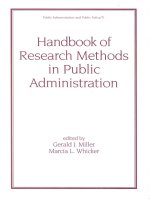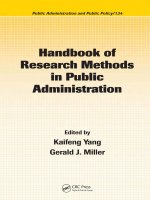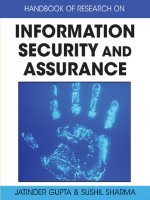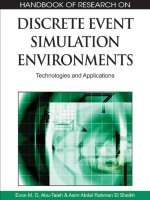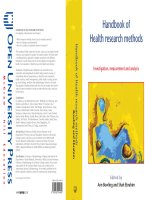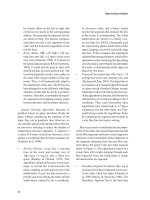handbook of research on discrete event simulation environments technologies and applications
Bạn đang xem bản rút gọn của tài liệu. Xem và tải ngay bản đầy đủ của tài liệu tại đây (22.44 MB, 610 trang )
Handbook of Research on
Discrete Event Simulation
Environments:
Technologies and Applications
Evon M. O. Abu-Taieh
Arab Academy for Banking and Financial Sciences, Jordan
Asim Abdel Rahman El Sheikh
Arab Academy for Banking and Financial Sciences, Jordan
Hershey • New York
InformatIon scIence reference
Director of Editorial Content: Kristin Klinger
Senior Managing Editor: Jamie Snavely
Assistant Managing Editor: Michael Brehm
Publishing Assistant: Sean Woznicki
Typesetter: Michael Killian, Sean Woznicki
Cover Design: Lisa Tosheff
Printed at: Yurchak Printing Inc.
Published in the United States of America by
Information Science Reference (an imprint of IGI Global)
701 E. Chocolate Avenue
Hershey PA 17033
Tel: 717-533-8845
Fax: 717-533-8661
E-mail:
Web site: />Copyright © 2010 by IGI Global. All rights reserved. No part of this publication may be reproduced, stored or distributed in
any form or by any means, electronic or mechanical, including photocopying, without written permission from the publisher.
Product or company names used in this set are for identication purposes only. Inclusion of the names of the products or
companies does not indicate a claim of ownership by IGI Global of the trademark or registered trademark.
Library of Congress Cataloging-in-Publication Data
Handbook of research on discrete event simulation environments : technologies and applications / Evon M.O. Abu-Taieh and
Asim Abdel Rahman El Sheikh, editors.
p. cm.
Includes bibliographical references and index.
Summary: "This book provides a comprehensive overview of theory and practice in simulation systems focusing on major
breakthroughs within the technological arena, with particular concentration on the accelerating principles, concepts and
applications" Provided by publisher.
ISBN 978-1-60566-774-4 (hardcover) ISBN 978-1-60566-775-1 (ebook) 1.
Discrete-time systems Computer simulation. I. Abu-Taieh, Evon M. O. II. El
Sheikh, Asim Abdel Rahman.
T57.62H365 2012
003'.830113 dc22
2009019592
British Cataloguing in Publication Data
A Cataloguing in Publication record for this book is available from the British Library.
All work contributed to this book is new, previously-unpublished material. The views expressed in this book are those of the
authors, but not necessarily of the publisher.
Editorial Advisory Board
Raymond R. Hill, Wright State University, USA
Firas Al-Khaldi, Arab Academy for Banking and Financial Sciences, Jordan
Jeihan Abu-Tayeh, The World Bank, Middle East and North Africa Region, USA
Tillal Eldabi, Brunel University, UK
Roberto Revetria, University of Genoa, Italy
Sabah Abutayeh, Housing Bank, Jordan
Michael Dupin, Harvard Medical School and Massachusetts General Hospital, USA
List of Contributors
Aboud, Sattar J. / Middle East University for Graduate Studies, Jordan 58
Abu-Taieh, Evon M. O. / Civil Aviation Regulatory Commission and Arab
Academy for Financial Sciences, Jordan 15
Abutayeh, Jeihan M. O. / World Bank, Jordan 15
Al-Bahadili, Hussein / The Arab Academy for Banking & Financial Sciences, Jordan 418
Al-Fayoumi, Mohammad / Middle East University for Graduate Studies, Jordan 58
Al-Hudhud, Ghada / Al-Ahlyia Amman University, Jordan 252
Alnoukari, Mouhib / Arab Academy for Banking and Financial Sciences, Syria 359
Alnuaimi, Mohamed / Middle East University for Graduate Studies, Jordan 58
Al-Qirem, Raed M. / Al-Zaytoonah University of Jordan, Jordan 484
Alzoabi, Zaidoun / Arab Academy for Banking and Financial Sciences, Syria 359
Capra, Lorenzo / Università degli Studi di Milano, Italy 191, 218
Cartaxo, Adolfo V. T. / Instituto de Telecomunicações, Portugal 143
Cassettari, Lucia / University of Genoa, Italy 92
Cazzola, Walter / Università degli Studi di Milano, Italy 191, 218
Cercas, Francisco A. B. / Instituto de Telecomunicações, Portugal 143
El Sheikh, Asim / Arab Academy for Banking and Financial Sciences, Jordan 359
Gamez, David / Imperial College, UK 337
Heath, Brian L. / Wright State University, USA 28
Hill, Raymond R. / Air Force Institute of Technology, USA 28
Kolker, Alexander / Children’s Hospital and Health Systems, USA 443
Korhonen, Ari / Helsinki University of Technology, Finland 234
Kubátová, Hana / Czech Technical University in Prague, Czech Republic 178
Lipovszki, Gyorgy / Budapest University of Technology and Economics, Hungary 284
Marzouk, Mohamed / Cairo University, Egypt 509
Membarth, Richard / University of Erlangen-Nuremberg, Erlangen, Germany 379
Molnar, Istvan / Bloomsburg University of Pennsylvania, USA 1, 284
Mosca, Roberto / University of Genoa, Italy 92
Revetria, Roberto / University of Genoa, Italy 92
Sarjoughian, Hessam / Arizona Center for Integrative Modeling and Simulation, USA 75
Sarkar, Nurul I. / AUT University, Auckland, New Zealand 379, 398
Sebastião, Pedro J. A. / Instituto de Telecomunicações, Portugal 143
Tolk, Andreas / Old Dominion University, USA 317
Wutzler, Thomas / Max Planck Institute for Biogeochemistry, Germany 75
Yaseen, Saad G. / Al-Zaytoonah University of Jordan, Jordan 484
Preface xvii
Acknowledgment xxiii
Chapter 1
Simulation: Body of Knowledge 1
Istvan Molnar, Bloomsburg University of Pennsylvania, USA
Chapter 2
Simulation Environments as Vocational and Training Tools 15
Evon M. O. Abu-Taieh, Civil Aviation Regulatory Commission and Arab Academy for
Financial Sciences, Jordan
Jeihan M. O. Abutayeh, World Bank, Jordan
Chapter 3
Agent-Based Modeling: A Historical Perspective and a Review of Validation and
Verication Efforts 28
Brian L. Heath, Wright State University, USA
Raymond R. Hill, Air Force Institute of Technology, USA
Chapter 4
Verication and Validation of Simulation Models 58
Sattar J. Aboud, Middle East University for Graduate Studies, Jordan
Mohammad Al-Fayoumi, Middle East University for Graduate Studies, Jordan
Mohamed Alnuaimi, Middle East University for Graduate Studies, Jordan
Chapter 5
DEVS-Based Simulation Interoperability 75
Thomas Wutzler, Max Planck Institute for Biogeochemistry, Germany
Hessam Sarjoughian, Arizona Center for Integrative Modeling and Simulation, USA
Table of Contents
Chapter 6
Experimental Error Measurement in Monte Carlo Simulation 92
Lucia Cassettari, University of Genoa, Italy
Roberto Mosca, University of Genoa, Italy
Roberto Revetria, University of Genoa, Italy
Chapter 7
Efcient Discrete Simulation of Coded Wireless Communication Systems 143
Pedro J. A. Sebastião, Instituto de Telecomunicações, Portugal
Francisco A. B. Cercas, Instituto de Telecomunicações, Portugal
Adolfo V. T. Cartaxo, Instituto de Telecomunicações, Portugal
Chapter 8
Teaching Principles of Petri Nets in Hardware Courses and Students Projects 178
Hana Kubátová, Czech Technical University in Prague, Czech Republic
Chapter 9
An Introduction to Reective Petri Nets 191
Lorenzo Capra, Università degli Studi di Milano, Italy
Walter Cazzola, Università degli Studi di Milano, Italy
Chapter 10
Trying Out Reective Petri Nets on a Dynamic Workow Case 218
Lorenzo Capra, Università degli Studi di Milano, Italy
Walter Cazzola, Università degli Studi di Milano, Italy
Chapter 11
Applications of Visual Algorithm Simulation 234
Ari Korhonen, Helsinki University of Technology, Finland
Chapter 12
Virtual Reality: A New Era of Simulation and Modelling 252
Ghada Al-Hudhud, Al-Ahlyia Amman University, Jordan
Chapter 13
Implementation of a DES Environment 284
Gyorgy Lipovszki, Budapest University of Technology and Economics, Hungary
Istvan Molnar, Bloomsburg University of Pennsylvania, USA
Chapter 14
Using Simulation Systems for Decision Support 317
Andreas Tolk, Old Dominion University, USA
Chapter 15
The Simulation of Spiking Neural Networks 337
David Gamez, Imperial College, UK
Chapter 16
An Integrated Data Mining and Simulation Solution 359
Mouhib Alnoukari, Arab Academy for Banking and Financial Sciences, Syria
Asim El Sheikh, Arab Academy for Banking and Financial Sciences, Jordan
Zaidoun Alzoabi, Arab Academy for Banking and Financial Sciences, Syria
Chapter 17
Modeling and Simulation of IEEE 802.11g using OMNeT++ 379
Nurul I. Sarkar, AUT University, Auckland, New Zealand
Richard Membarth, University of Erlangen-Nuremberg, Erlangen, Germany
Chapter 18
Performance Modeling of IEEE 802.11 WLAN using OPNET: A Tutorial 398
Nurul I. Sarkar, AUT University, New Zealand
Chapter 19
On the Use of Discrete-Event Simulation in Computer Networks Analysis and Design 418
Hussein Al-Bahadili, The Arab Academy for Banking & Financial Sciences, Jordan
Chapter 20
Queuing Theory and Discrete Events Simulation for Health Care: From Basic Processes to
Complex Systems with Interdependencies 443
Alexander Kolker, Children’s Hospital and Health Systems, USA
Chapter 21
Modelling a Small Firm in Jordan Using System Dynamics 484
Raed M. Al-Qirem, Al-Zaytoonah University of Jordan, Jordan
Saad G. Yaseen, Al-Zaytoonah University of Jordan, Jordan
Chapter 22
The State of Computer Simulation Applications in Construction 509
Mohamed Marzouk, Cairo University, Egypt
Compilation of References 535
About the Contributors 570
Index 578
Preface xvii
Acknowledgment xxiii
Chapter 1
Simulation: Body of Knowledge 1
Istvan Molnar, Bloomsburg University of Pennsylvania, USA
Chapter 1, Simulation: Body of Knowledge, attempts to dene the knowledge body of simulation and
describes the underlying principles of simulation education. It argues that any programs in Modelling and
Simulation should recognize the multi-and interdisciplinary character of the eld and realize the program
in wide co-operation. The paper starts with the clarication of the major objectives and principles of the
Modelling and Simulation Program and the related degrees, based on a broad business and real world
perspective. After reviewing students’ background, especially the communication, interpersonal, and
team skills, the analytical and critical thinking skills, furthermore some of the additional skills leading
to a career, the employer’s view and possible career paths are examined. Finally, the core knowledge
body, the curriculum design and program related issues are discussed. The author hopes to contribute to
the recent discussions about modelling and simulation education and the profession.
Chapter 2
Simulation Environments as Vocational and Training Tools 15
Evon M. O. Abu-Taieh, Civil Aviation Regulatory Commission and Arab Academy for
Financial Sciences, Jordan
Jeihan M. O. Abutayeh, World Bank, Jordan
Chapter 2, Simulation Environments as Vocational and Training Tools, investigates over 50 simula-
tion packages and simulators used in vocational and course training in many elds. Accordingly, the
50 simulation packages were categorized in the following elds: Pilot Training, Chemistry, Physics,
Mathematics, Environment and ecological systems, Cosmology and astrophysics, Medicine and Surgery
training, Cosmetic surgery, Engineering – Civil engineering, architecture, interior design, Computer and
communication networks, Stock Market Analysis, Financial Models and Marketing, Military Training
and Virtual Reality. The incentive for using simulation environments as vocational and training tools
is to save live, money and effort.
Table of Contents
Chapter 3
Agent-Based Modeling: A Historical Perspective and a Review of Validation and
Verication Efforts 28
Brian L. Heath, Wright State University, USA
Raymond R. Hill, Air Force Institute of Technology, USA
Chapter 3, Agent-Based Modeling: A Historical Perspective and a Review of Validation and Verication
Efforts, traces the historical roots of agent-based modeling. This review examines the modern inu-
ences of systems thinking, cybernetics as well as chaos and complexity on the growth of agent-based
modeling. The chapter then examines the philosophical foundations of simulation verication and
validation. Simulation verication and validation can be viewed from two quite different perspectives:
the simulation philosopher and the simulation practitioner. Personnel from either camp are typically
unaware of the other camp’s view of simulation verication and validation. This chapter examines
both camps while also providing a survey of the literature and efforts pertaining to the verication and
validation of agent-based models.
Chapter 4
Verication and Validation of Simulation Models 58
Sattar J. Aboud, Middle East University for Graduate Studies, Jordan
Mohammad Al-Fayoumi, Middle East University for Graduate Studies, Jordan
Mohamed Alnuaimi, Middle East University for Graduate Studies, Jordan
Chapter 4, Verication and Validation of Simulation Models, discusses validation and verication of simu-
lation models. The different approaches to deciding model validity are presented; how model validation
and verication relate to the model development process are discussed; various validation techniques are
dened; conceptual model validity, model verication, operational validity, and data validity; superior
verication and validation technique for simulation models relied on a multistage approach are described;
ways to document results are given; and a recommended procedure is presented.
Chapter 5
DEVS-Based Simulation Interoperability 75
Thomas Wutzler, Max Planck Institute for Biogeochemistry, Germany
Hessam Sarjoughian, Arizona Center for Integrative Modeling and Simulation, USA
Chapter 5, DEVS-Based Simulation Interoperability, introduces the usage of DEVS for the purpose
of implementing interoperability across heterogeneous simulation models. It shows that the DEVS
framework provides a simple, yet effective conceptual basis for handling simulation interoperability. It
discusses the various useful properties of the DEVS framework, describes the Shared Abstract Model
(SAM) approach for interoperating simulation models, and compares it to other approaches. The DEVS
approach enables formal model specication with component models implemented in multiple program-
ming languages. The simplicity of the integration of component models designed in the DEVS, DTSS,
and DESS simulation formalisms and implemented in the programming languages Java and C++ is
demonstrated by a basic educational example and by a real world forest carbon accounting model. The
authors hope, that readers will appreciate the combination of generalness and simplicity and that readers
will consider using the DEVS approach for simulation interoperability in their own projects.
Chapter 6
Experimental Error Measurement in Monte Carlo Simulation 92
Lucia Cassettari, University of Genoa, Italy
Roberto Mosca, University of Genoa, Italy
Roberto Revetria, University of Genoa, Italy
Chapter 6, Experimental Error Measurement in Monte Carlo Simulation, describes the set up step series,
developed by the Genoa Research Group on Production System Simulation at the beginning of the ’80s,
as a sequence, through which it is possible at rst statistically validate the simulator, then estimate the
variables which effectively affect the different target functions, then obtain, through the regression meta-
models, the relations linking the independent variables to the dependent ones (target functions) and,
nally, proceed to the detection of the optimal functioning conditions. The authors pay great attention
to the treatment, the evaluation and control of the Experimental Error, under the form of Mean Square
Pure Error (MS
PE
), a measurement which is always culpably neglected in the traditional experimentation
on the simulation models but, that potentially can consistently invalidate with its magnitude the value
of the results obtained from the model.
Chapter 7
Efcient Discrete Simulation of Coded Wireless Communication Systems 143
Pedro J. A. Sebastião, Instituto de Telecomunicações, Portugal
Francisco A. B. Cercas, Instituto de Telecomunicações, Portugal
Adolfo V. T. Cartaxo, Instituto de Telecomunicações, Portugal
Chapter 7, Efcient Discrete Simulation of Coded Wireless Communication Systems, presents a simula-
tion method, named Accelerated Simulation Method (ASM), that provides a high degree of efciency
and accuracy, namely for lower BER, where the application of methods like the Monte Carlo simulation
method (MCSM) is prohibitive, due to high computational and time requirements. The present work
generalizes the application of the ASM to a Wireless Communication System’s (WCS) modelled as a
stochastic discrete channel model, considering a real channel, where there are several random effects
that result in random energy uctuations of the received symbols. The performance of the coded WCS
is assessed efciently, with soft-decision (SD) and hard-decision (HD) decoding. The authors show
that this new method already achieves a time efciency of two or three orders of magnitude for SD and
HD, considering a BER = 1 × 10
-4
when compared to MCSM. The presented performance results are
compared with the MCSM, to check its accuracy.
Chapter 8
Teaching Principles of Petri Nets in Hardware Courses and Students Projects 178
Hana Kubátová, Czech Technical University in Prague, Czech Republic
Chapter 8, Teaching Principles of Petri Nets in Hardware Courses and Student’s Projects, presents the
principles of using Petri Net formalism in hardware design courses, especially in the course “Architec-
ture of peripheral devices”. Several models and results obtained by student individual or group projects
are mentioned. First the using of formalism as a modeling tool is presented consecutively from Place/
Transition nets to Coloured Petri nets. Then the possible Petri Nets using as a hardware specication
for direct hardware implementation (synthesized VHDL for FPGA) is described. Implementation and
simulation results of three directly implemented models are presented
Chapter 9
An Introduction to Reective Petri Nets 191
Lorenzo Capra, Università degli Studi di Milano, Italy
Walter Cazzola, Università degli Studi di Milano, Italy
Chapter 9, An Introduction to Reective Petri Nets, introduces Reective Petri nets, a formal model for
dynamic discrete-event systems. Based on a typical reective architecture, in which functional aspects
are cleanly separated from evolutionary ones, that model preserves the description effectiveness and
the analysis capabilities of Petri nets. On the short-time perspective of implementing a discrete-event
simulation engine, Reective Petri nets are provided with timed state-transition semantics.
Chapter 10
Trying Out Reective Petri Nets on a Dynamic Workow Case 218
Lorenzo Capra, Università degli Studi di Milano, Italy
Walter Cazzola, Università degli Studi di Milano, Italy
Chapter 10, Trying out Reective Petri Nets on a Dynamic Workow Case, proposes a recent Petri
net-based reective layout, called Reective Petri nets, as a formal model for dynamic workows. A
localized open problem is considered: how to determine what tasks should be redone and which ones
do not when transferring a workow instance from an old to a new template. The problem is efciently
but rather empirically addressed in a workow management system. The proposed approach is formal,
may be generalized, and is based on the preservation of classical Petri nets structural properties, which
permit an efcient characterization of workow’s soundness.
Chapter 11
Applications of Visual Algorithm Simulation 234
Ari Korhonen, Helsinki University of Technology, Finland
Chapter 11, Applications of Visual Algorithm Simulation, represent a novel idea to promote the interaction
between the user and the algorithm visualization system called visual algorithm simulation. As a proof
of concept, the chapter represents an application framework called Matrix that encapsulates the idea of
visual algorithm simulation. The framework is applied by the TRAKLA2 learning environment in which
algorithm simulation is employed to produce algorithm simulation exercises. Moreover, the benets of
such exercises and applications of visual algorithm simulation in general are discussed.
Chapter 12
Virtual Reality: A New Era of Simulation and Modelling 252
Ghada Al-Hudhud, Al-Ahlyia Amman University, Jordan
Chapter 12, Virtual Reality: New Era of Simulation And Modelling, represent a novel idea to promote the
interaction between the user and the algorithm visualization system called visual algorithm simulation.
As a proof of concept, the chapter represents an application framework called Matrix that encapsulates
the idea of visual algorithm simulation. The framework is applied by the TRAKLA2 learning environ-
ment in which algorithm simulation is employed to produce algorithm simulation exercises. Moreover,
the benets of such exercises and applications of visual algorithm simulation in general are discussed.
Chapter 13
Implementation of a DES Environment 284
Gyorgy Lipovszki, Budapest University of Technology and Economics, Hungary
Istvan Molnar, Bloomsburg University of Pennsylvania, USA
Chapter 13, Case Study: Implementation of a DES Environment, describes a program system that imple-
ments a Discrete Event Simulation (DES) development environment. The simulation environment was
created using the LabVIEW graphical programming system; a National Instruments software product.
In this programming environment the user can connect different procedures and data structures with
“graphical wires” to implement a simulation model, thereby creating an executable simulation program.
The connected individual objects simulate a discrete event problem. The chapter describes all simulation
model objects, their attributes and methods. Another important element of the discrete event simulator is
the task list, which has also been created using task type objects. The simulation system uses the “next
event simulation” technique and refreshes the actual state (attribute values of all model objects) at every
event. The state changes are determined by the entity objects, their input, current content, and output.
Every model object can access (read) all and modify (write) a selected number of object attribute values.
This property of the simulation system provides the possibility to build a complex discrete event system
using predened discrete event model objects.
Chapter 14
Using Simulation Systems for Decision Support 317
Andreas Tolk, Old Dominion University, USA
Chapter 14, Using Simulation Systems for Decision Support, describes the use of simulation systems
for decision support in support of real operations, which is the most challenging application domain in
the discipline of modeling and simulation. To this end, the systems must be integrated as services into
the operational infrastructure. To support discovery, selection, and composition of services, they need
to be annotated regarding technical, syntactic, semantic, pragmatic, dynamic, and conceptual catego-
ries. The systems themselves must be complete and validated. The data must be obtainable, preferably
via common protocols shared with the operational infrastructure. Agents and automated forces must
produce situation adequate behavior. If these requirements for simulation systems and their annotations
are fullled, decision support simulation can contribute signicantly to the situational awareness up to
cognitive levels of the decision maker.
Chapter 15
The Simulation of Spiking Neural Networks 337
David Gamez, Imperial College, UK
Chapter 15, Discrete Event Simulation of Spiking Neural Networks, is an overview of the simulation
of spiking neural networks that relates discrete event simulation to other approaches. To illustrate the
issues surrounding this work, the second half of this chapter presents a case study of the SpikeStream
neural simulator that covers the architecture, performance and typical applications of this software along
with some recent experiments.
Chapter 16
An Integrated Data Mining and Simulation Solution 359
Mouhib Alnoukari, Arab Academy for Banking and Financial Sciences, Syria
Asim El Sheikh, Arab Academy for Banking and Financial Sciences, Jordan
Zaidoun Alzoabi, Arab Academy for Banking and Financial Sciences, Syria
Chapter 16, An Integrated Data Mining and Simulation Solution, we will propose an intelligent DSS
framework based on data mining and simulation integration. The main output of this framework is the
increase of knowledge. Two case studies are presented, the rst one on car market demand simulation.
The simulation model was built using neural networks to get the rst set of prediction results. Data min-
ing methodology used named ANFIS (Adaptive Neuro-Fuzzy Inference System). The second case study
demonstrates how applying data mining and simulation in assuring quality in higher education
Chapter 17
Modeling and Simulation of IEEE 802.11g using OMNeT++ 379
Nurul I. Sarkar, AUT University, Auckland, New Zealand
Richard Membarth, University of Erlangen-Nuremberg, Erlangen, Germany
Chapter 17, Modeling and Simulation of IEEE 802.11g using OMNeT++, aims to provide a tutorial on
OMNeT++ focusing on modeling and performance study of the IEEE 802.11g wireless network. Due
to the complex nature of computer and telecommunication networks, it is often difcult to predict the
impact of different parameters on system performance especially when deploying wireless networks.
Computer simulation has become a popular methodology for performance study of computer and telecom-
munication networks. This popularity results from the availability of various sophisticated and powerful
simulation software packages, and also because of the exibility in model construction and validation
offered by simulation. While various network simulators exist for building a variety of network models,
choosing a good network simulator is very important in modeling and performance analysis of wireless
networks. A good simulator is one that is easy to use; more exible in model development, modication
and validation; and incorporates appropriate analysis of simulation output data, pseudo-random number
generators, and statistical accuracy of the simulation results. OMNeT++ is becoming one of the most
popular network simulators because it has all the features of a good simulator.
Chapter 18
Performance Modeling of IEEE 802.11 WLAN using OPNET: A Tutorial 398
Nurul I. Sarkar, AUT University, New Zealand
Chapter 18, Performance Modeling of IEEE 802.11 WLAN using OPNET: A Tutorial, aims to provide
a tutorial on OPNET focusing on the simulation and performance modeling of IEEE 802.11 wireless
local area networks (WLANs). Results obtained show that OPNET provides credible simulation results
close to a real system.
Chapter 19
On the Use of Discrete-Event Simulation in Computer Networks Analysis and Design 418
Hussein Al-Bahadili, The Arab Academy for Banking & Financial Sciences, Jordan
Chapter 19, On the Use of Discrete-Event Simulation in Computer Networks Analysis and Design, de-
scribes a newly developed research-level computer network simulator, which can be used to evaluate the
performance of a number of ooding algorithms in ideal and realistic mobile ad hoc network (MANET)
environments. It is referred to as MANSim.
Chapter 20
Queuing Theory and Discrete Events Simulation for Health Care: From Basic Processes to
Complex Systems with Interdependencies 443
Alexander Kolker, Children’s Hospital and Health Systems, USA
Chapter 20, Queuing Theory and Discrete Events Simulation for Health Care: From Basic Processes
to Complex Systems with Interdependenciess, objective is twofold: (i) to illustrate practical limitations
of queuing analytic (QA) compared to Discrete-event simulation (DES) by applying both of them to
analyze the same problems, and (ii) to demonstrate practical application of DES models starting from
simple examples and proceeding to rather advanced models.
Chapter 21
Modelling a Small Firm in Jordan Using System Dynamics 484
Raed M. Al-Qirem, Al-Zaytoonah University of Jordan, Jordan
Saad G. Yaseen, Al-Zaytoonah University of Jordan, Jordan
Chapter 21, Modelling a Small Firm in Jordan Using System Dynamics, objective of this chapter is to
introduce new performance measures using systems thinking paradigm that can be used by the Jordanian
banks to assess the credit worthiness of rms applying for credit. A simulator based on system dynamics
methodology which is the thinking tool presented in this chapter. The system dynamics methodology
allows the bank to test “What If” scenarios based on a model which captures the behavior of the real
system over time.
Chapter 22
The State of Computer Simulation Applications in Construction 509
Mohamed Marzouk, Cairo University, Egypt
Chapter 22, The State of Computer Simulation Applications in Construction, presents an overview
of computer simulation efforts that have been performed in the area of construction engineering and
management. Also, it presents two computer simulation applications in construction; earthmoving and
construction of bridges’ decks. Comprehensive case studies are worked out to illustrate the practicality
of using computer simulation in scheduling construction projects, taking into account the associated
uncertainties inherited in construction operations.
Compilation of References 535
About the Contributors 570
Index 578
xvii
Preface
The Chinese Proverb cites that “I hear and I forget. I see and I remember. I do and I understand”, in this
context, Simulation is the next best thing after the “I do” part, as it is the nearest thing to giving real
life picture to images in the mind. Mirrors reect real life into no existing picture, whereas simulation
embodies our notions and ideas into a picture that cannot only be seen, but played and experimented
with as well. Simulation environments exist on a number of dimensions in the market.
The desirable features in Discrete Event Simulation environments are taxonomiesed as modeling
features, simulation systems features, and implementation features. While the modeling features include
modularity, reuse and the hierarchical structure of the model, the simulation systems features include the
scalability, portability, and interoperability of the simulation system, and the implementations features
include distribution execution, execution over the internet, and ease of use. In order to accomplish the
aforementioned desirable features, many components must be examined, while taking into account the
market supply and demand factors. Actually, the race to accomplish such desirable features is as old as
simulation itself. The components to be examined in this book are: Methodologies, Simulation language,
Tutorials, Statistical analysis packages, Modeling, Animation, Interface, interoperability standards, Uses
and Applications, Stochastic / Deterministic, Time handling, and History.
In Handbook of Research on Discrete Event Simulation Environments: Technologies and Ap-
plications, simulation is discussed from within the different features of theory and application. The
goal of this book is not to look at simulation from traditional perspectives, but to illustrate the benets
and issues that arise from the application of simulation within other disciplines. This book focuses on
major breakthroughs within the technological arena, with particular concentration on the accelerating
principles, concepts and applications.
The book caters to the needs of scholars, PhD candidates, researchers, as well as, graduate level stu-
dents of computer science, operations research, and economics disciplines. The target audience for this
book also includes academic libraries throughout the world that are interested in cutting edge research.
Another important segment of readers are students of Master of Business Administration (MBA) and
Master of Public Affairs (MPA) programs, which include information systems components as part of
their curriculum. To make the book accessible to all, a companion website was developed, which can
be reached through the link ( />This book is organized in 22 chapters. On the whole, the chapters of this book fall into ve categories,
while crossing paths with different disciplines, of which the rst, Simulation Prelude, concentrates on
simulation theory, while the second concentrates on Petri Nets, whereas the third section concentrates
on Monte Carlo, besides the fourth section that sheds light on visualization and real-time simulation,
likewise, the fth section, living simulation, gives color to the black and white picture. The fth section
xviii
discusses simulation applications in neural networks, data mining, networks, banks, construction, thereby
aiming to enrich this book with others knowledge, experience, thought and insight.
Chapter 1, Simulation: Body of Knowledge, attempts to dene the knowledge body of simulation and
describes the underlying principles of simulation education. It argues that any programs in Modelling and
Simulation should recognize the multi-and interdisciplinary character of the eld and realize the program
in wide co-operation. The chapter starts with the clarication of the major objectives and principles of
the Modelling and Simulation Program and the related degrees, based on a broad business and real world
perspective. After reviewing students’ background, especially the communication, interpersonal, and
team skills, the analytical and critical thinking skills, furthermore some of the additional skills leading
to a career, the employer’s view and possible career paths are examined. Finally, the core knowledge
body, the curriculum design and program related issues are discussed. The author hopes to contribute to
the recent discussions about modelling and simulation education and the profession.
Chapter 2, Simulation Environments as Vocational and Training Tools, investigates over 50 simula-
tion packages and simulators used in vocational and course training in many elds. Accordingly, the
50 simulation packages were categorized in the following elds: Pilot Training, Chemistry, Physics,
Mathematics, Environment and ecological systems, Cosmology and astrophysics, Medicine and Surgery
training, Cosmetic surgery, Engineering – Civil engineering, architecture, interior design, Computer and
communication networks, Stock Market Analysis, Financial Models and Marketing, Military Training
and Virtual Reality. The incentive for using simulation environments as vocational and training tools
is to save live, money and effort.
Chapter 3, Agent-Based Modeling: A Historical Perspective and a Review of Validation and Veri-
cation Efforts, traces the historical roots of agent-based modeling. This review examines the modern
inuences of systems thinking, cybernetics as well as chaos and complexity on the growth of agent-
based modeling. The chapter then examines the philosophical foundations of simulation verication and
validation. Simulation verication and validation can be viewed from two quite different perspectives:
the simulation philosopher and the simulation practitioner. Personnel from either camp are typically
unaware of the other camp’s view of simulation verication and validation. This chapter examines
both camps while also providing a survey of the literature and efforts pertaining to the verication and
validation of agent-based models.
Chapter 4, Verication and Validation of Simulation Models, discusses validation and verication
of simulation models. The different approaches to deciding model validity are presented; how model
validation and verication relate to the model development process are discussed; various validation
techniques are dened; conceptual model validity, model verication, operational validity, and data valid-
ity; superior verication and validation technique for simulation models relied on a multistage approach
are described; ways to document results are given; and a recommended procedure is presented.
Chapter 5, DEVS-Based Simulation Interoperability, introduces the usage of DEVS for the purpose
of implementing interoperability across heterogeneous simulation models. It shows that the DEVS
framework provides a simple, yet effective conceptual basis for handling simulation interoperability. It
discusses the various useful properties of the DEVS framework, describes the Shared Abstract Model
(SAM) approach for interoperating simulation models, and compares it to other approaches. The DEVS
approach enables formal model specication with component models implemented in multiple program-
ming languages. The simplicity of the integration of component models designed in the DEVS, DTSS,
and DESS simulation formalisms and implemented in the programming languages Java and C++ is
demonstrated by a basic educational example and by a real world forest carbon accounting model. The
xix
authors hope, that readers will appreciate the combination of generalness and simplicity and that readers
will consider using the DEVS approach for simulation interoperability in their own projects.
The second section concentrates on, Monte Carlo Simulation where it is covered in chapter 6 and 7
as follows:
Chapter 6, Experimental Error Measurement in Monte Carlo Simulation, describes the set up step
series, developed by the Genoa Research Group on Production System Simulation at the beginning of the
’80s, as a sequence, through which it is possible at rst statistically validate the simulator, then estimate
the variables which effectively affect the different target functions, then obtain, through the regression
meta-models, the relations linking the independent variables to the dependent ones (target functions) and,
nally, proceed to the detection of the optimal functioning conditions. The authors pay great attention
to the treatment, the evaluation and control of the Experimental Error, under the form of Mean Square
Pure Error (MS
PE
), a measurement which is always culpably neglected in the traditional experimentation
on the simulation models but, that potentially can consistently invalidate with its magnitude the value
of the results obtained from the model.
Chapter 7, Efcient Discrete Simulation of Coded Wireless Communication Systems, presents a simu-
lation method, named Accelerated Simulation Method (ASM), that provides a high degree of efciency
and accuracy, namely for lower BER, where the application of methods like the Monte Carlo simulation
method (MCSM) is prohibitive, due to high computational and time requirements. The present work
generalizes the application of the ASM to a Wireless Communication System’s (WCS) modelled as a
stochastic discrete channel model, considering a real channel, where there are several random effects
that result in random energy uctuations of the received symbols. The performance of the coded WCS
is assessed efciently, with soft-decision (SD) and hard-decision (HD) decoding. The authors show
that this new method already achieves a time efciency of two or three orders of magnitude for SD and
HD, considering a BER = 1 × 10
-4
when compared to MCSM. The presented performance results are
compared with the MCSM, to check its accuracy.
The third part of the book concentrates on Petri Nets. The chapters 8 through 10 cover this part as
follows:
Chapter 8, Teaching Principles of Petri Nets in Hardware Courses and Student’s Projects, presents
the principles of using Petri Net formalism in hardware design courses, especially in the course “Ar-
chitecture of peripheral devices”. Several models and results obtained by student individual or group
projects are mentioned. First the using of formalism as a modeling tool is presented consecutively from
Place/Transition nets to Coloured Petri nets. Then the possible Petri Nets using as a hardware specica-
tion for direct hardware implementation (synthesized VHDL for FPGA) is described. Implementation
and simulation results of three directly implemented models are presented
Chapter 9, An Introduction to Reective Petri Nets, introduces Reective Petri nets, a formal model
for dynamic discrete-event systems. Based on a typical reective architecture, in which functional aspects
are cleanly separated from evolutionary ones, that model preserves the description effectiveness and
the analysis capabilities of Petri nets. On the short-time perspective of implementing a discrete-event
simulation engine, Reective Petri nets are provided with timed state-transition semantics.
Chapter 10, Trying out Reective Petri Nets on a Dynamic Workow Case, proposes a recent Petri
net-based reective layout, called Reective Petri nets, as a formal model for dynamic workows. A
localized open problem is considered: how to determine what tasks should be redone and which ones
do not when transferring a workow instance from an old to a new template. The problem is efciently
but rather empirically addressed in a workow management system. The proposed approach is formal,
xx
may be generalized, and is based on the preservation of classical Petri nets structural properties, which
permit an efcient characterization of workow’s soundness.
The fourth section of the book concentrates on visualization and real-time simulation. The chapters
11 through 14 cover this part as follows:
Chapter 11, Applications of Visual Algorithm Simulation, represent a novel idea to promote the inter-
action between the user and the algorithm visualization system called visual algorithm simulation. As a
proof of concept, the chapter represents an application framework called Matrix that encapsulates the
idea of visual algorithm simulation. The framework is applied by the TRAKLA2 learning environment
in which algorithm simulation is employed to produce algorithm simulation exercises. Moreover, the
benets of such exercises and applications of visual algorithm simulation in general are discussed.
Chapter 12, Virtual Reality: A New Era of Simulation And Modelling, represent a novel idea to pro-
mote the interaction between the user and the algorithm visualization system called visual algorithm
simulation. As a proof of concept, the chapter represents an application framework called Matrix that
encapsulates the idea of visual algorithm simulation. The framework is applied by the TRAKLA2 learn-
ing environment in which algorithm simulation is employed to produce algorithm simulation exercises.
Moreover, the benets of such exercises and applications of visual algorithm simulation in general are
discussed.
Chapter 13, Implementation of a DES Environment, describes a program system that implements a
Discrete Event Simulation (DES) development environment. The simulation environment was created
using the LabVIEW graphical programming system; a National Instruments software product. In this
programming environment the user can connect different procedures and data structures with “graphi-
cal wires” to implement a simulation model, thereby creating an executable simulation program. The
connected individual objects simulate a discrete event problem. The chapter describes all simulation
model objects, their attributes and methods. Another important element of the discrete event simulator is
the task list, which has also been created using task type objects. The simulation system uses the “next
event simulation” technique and refreshes the actual state (attribute values of all model objects) at every
event. The state changes are determined by the entity objects, their input, current content, and output.
Every model object can access (read) all and modify (write) a selected number of object attribute values.
This property of the simulation system provides the possibility to build a complex discrete event system
using predened discrete event model objects.
Chapter 14, Using Simulation Systems for Decision Support, describes the use of simulation systems
for decision support in support of real operations, which is the most challenging application domain in
the discipline of modeling and simulation. To this end, the systems must be integrated as services into
the operational infrastructure. To support discovery, selection, and composition of services, they need
to be annotated regarding technical, syntactic, semantic, pragmatic, dynamic, and conceptual catego-
ries. The systems themselves must be complete and validated. The data must be obtainable, preferably
via common protocols shared with the operational infrastructure. Agents and automated forces must
produce situation adequate behavior. If these requirements for simulation systems and their annotations
are fullled, decision support simulation can contribute signicantly to the situational awareness up to
cognitive levels of the decision maker.
The nal part of the book, living simulation, The chapters 15 through 22 cover this part as follows:
Chapter 15, The Simulation of Spiking Neural Networks, is an overview of the simulation of spik-
ing neural networks that relates discrete event simulation to other approaches. To illustrate the issues
surrounding this work, the second half of this chapter presents a case study of the SpikeStream neural
xxi
simulator that covers the architecture, performance and typical applications of this software along with
some recent experiments.
Chapter 16, An Integrated Data Mining and Simulation Solution, we will propose an intelligent DSS
framework based on data mining and simulation integration. The main output of this framework is the
increase of knowledge. Two case studies are presented, the rst one on car market demand simulation.
The simulation model was built using neural networks to get the rst set of prediction results. Data min-
ing methodology used named ANFIS (Adaptive Neuro-Fuzzy Inference System). The second case study
demonstrates how applying data mining and simulation in assuring quality in higher education
Chapter 17, Modeling and Simulation of IEEE 802.11g using OMNeT++, aims to provide a tutorial
on OMNeT++ focusing on modeling and performance study of the IEEE 802.11g wireless network.
Due to the complex nature of computer and telecommunication networks, it is often difcult to predict
the impact of different parameters on system performance especially when deploying wireless networks.
Computer simulation has become a popular methodology for performance study of computer and telecom-
munication networks. This popularity results from the availability of various sophisticated and powerful
simulation software packages, and also because of the exibility in model construction and validation
offered by simulation. While various network simulators exist for building a variety of network models,
choosing a good network simulator is very important in modeling and performance analysis of wireless
networks. A good simulator is one that is easy to use; more exible in model development, modication
and validation; and incorporates appropriate analysis of simulation output data, pseudo-random number
generators, and statistical accuracy of the simulation results. OMNeT++ is becoming one of the most
popular network simulators because it has all the features of a good simulator.
Chapter 18, Performance Modeling of IEEE 802.11 WLAN using OPNET: A Tutorial, aims to provide
a tutorial on OPNET focusing on the simulation and performance modeling of IEEE 802.11 wireless
local area networks (WLANs). Results obtained show that OPNET provides credible simulation results
close to a real system.
Chapter 19, On the Use of Discrete-Event Simulation in Computer Networks Analysis and Design,
describes a newly developed research-level computer network simulator, which can be used to evalu-
ate the performance of a number of ooding algorithms in ideal and realistic mobile ad hoc network
(MANET) environments. It is referred to as MANSim.
Chapter 20, Queuing Theory and Discrete Events Simulation for Health Care: From Basic Processes
to Complex Systems with Interdependencies, objective is twofold: (i) to illustrate practical limitations
of queuing analytic (QA) compared to Discrete-event simulation (DES) by applying both of them to
analyze the same problems, and (ii) to demonstrate practical application of DES models starting from
simple examples and proceeding to rather advanced models.
Chapter 21, Modelling a Small Firm in Jordan Using System Dynamics, objective of this chapter
is to introduce new performance measures using systems thinking paradigm that can be used by the
Jordanian banks to assess the credit worthiness of rms applying for credit. A simulator based on sys-
tem dynamics methodology which is the thinking tool presented in this chapter. The system dynamics
methodology allows the bank to test “What If” scenarios based on a model which captures the behavior
of the real system over time.
Chapter 22, The State of Computer Simulation Applications in Construction, presents an overview
of computer simulation efforts that have been performed in the area of construction engineering and
management. Also, it presents two computer simulation applications in construction; earthmoving and
construction of bridges’ decks. Comprehensive case studies are worked out to illustrate the practicality
xxii
of using computer simulation in scheduling construction projects, taking into account the associated
uncertainties inherited in construction operations.
In conclusion, it is worth reafrming that this book is not meant to look at simulation from within
the different features of theory and application, nor is the goal of this book to look at simulation from
traditional perspectives, in fact this book points toward illustrating the benets and issues that arise from
the application of simulation within other disciplines. As such, this book is organized in 22 chapters,
sorted into ve categories, while crossing paths with different disciplines, of which the rst, Simulation
Prelude, concentrated on simulation theory, while the second concentrated on Petri Nets, whereas the
third section concentrated on Monte Carlo, besides the fourth section that shed light on visualization
and real-time simulation, concluding in the fth section, living simulation, which gave color to the black
and white picture, as it discussed simulation applications in neural networks, data mining, networks,
banks, construction.
xxiii
Acknowledgment
The editors would like to acknowledge the relentless support of the IGI Global team, as their help and
patience have been innite and signicant. Moreover, the authors would like to extend their gratitude
to Mehdi Khosrow-Pour Executive Director of the Information Resources Management Association
and Jan Travers the Vice President. Likewise, the authors would like to extend their appreciation to
the Development Division at IGI Global; namely Julia Mosemann- the Development Editor, Rebecca
Beistline- the Assistant Development Editor and Christine Bufton- the Editorial Assistant.
In this regard, the authors would like to express their recognition to their respective organizations
and colleagues for the moral support and encouragement that have proved to be indispensable. In the
same token, the editors would like to thank the reviewers for their relentless work and for their constant
demand for perfection.
More importantly, the authors would like to extend their sincere appreciation and indebtedness to
their family for their love, support, and patience. Also, as 2009 is the International Year of Astronomy,
we dedicated this work in memory of the Father of Modern Science Galileo Galilei who stated once
“But it does move”.
Evon M. Abu-Taieh, PhD
Asim A. El-Sheikh, PhD
Editors
